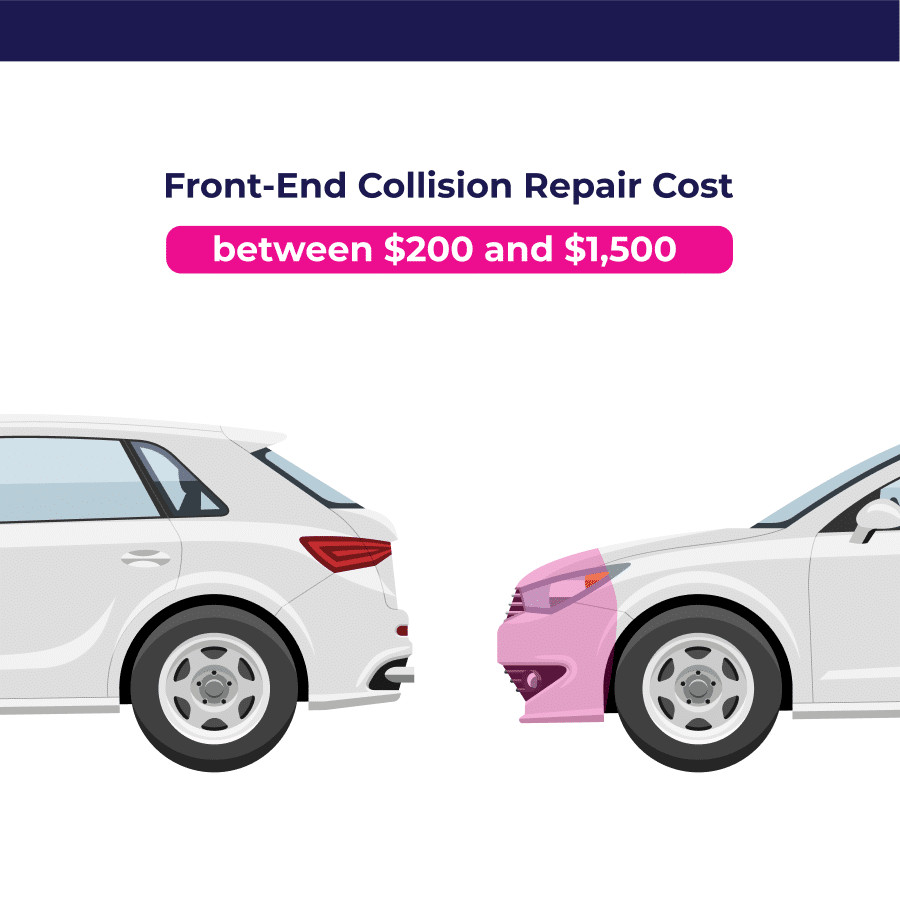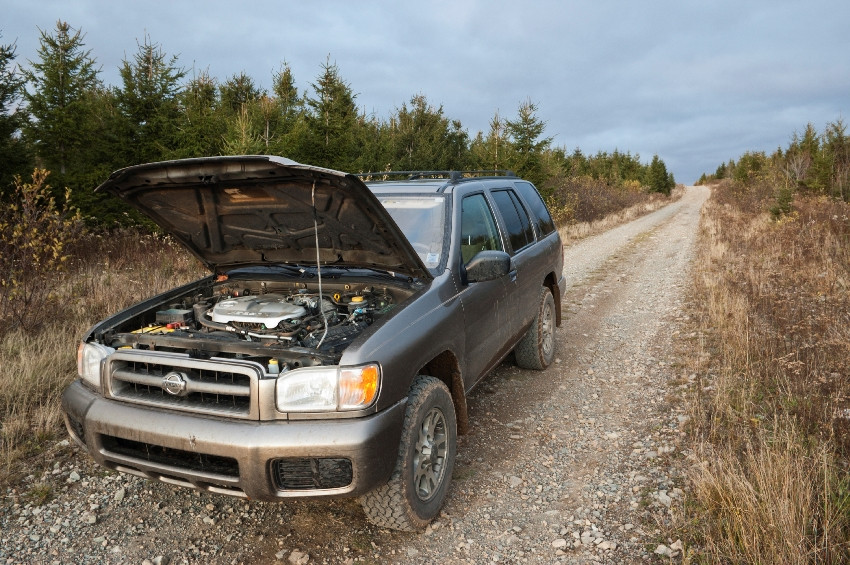How Much To Fix Front Of Car: A Comprehensive Guide

Fixing the front of your car after a collision can be a daunting prospect. CARDIAGTECH.NET is here to illuminate the factors influencing the cost to repair front-end damage, ensuring you’re equipped with the knowledge to navigate the process confidently. Discover comprehensive solutions and cost-saving strategies for vehicle restoration. Explore options for collision repair and discover vehicle maintenance insights for optimal car care.
1. Understanding Front-End Collision Repair Costs
 Front-end collision
Front-end collision
Front-end collisions can range from minor fender benders to severe impacts affecting the engine and frame. The cost to fix the front of your car varies widely depending on the extent of the damage. Let’s explore the typical price ranges and what factors influence them.
The average cost to fix the front of your car can range from $200 to $10,000 or more. This broad range considers factors like bumper damage, headlight repair, radiator issues, and potential engine work. It’s essential to understand these variables to anticipate potential expenses accurately.
1.1 Factors Influencing Front-End Repair Costs
Several key elements determine the final cost of front-end collision repairs.
- Extent of Damage: Minor scratches and dents are cheaper to fix than significant structural damage.
- Parts Replacement: Replacing parts like headlights, bumpers, or the radiator significantly increases costs.
- Labor Costs: The complexity of the repair affects the labor hours, impacting the total expense.
- Vehicle Type: Luxury or newer vehicles often have pricier parts and specialized repair requirements.
According to a report by the National Highway Traffic Safety Administration (NHTSA), front-end collisions account for a significant percentage of accidents, making understanding these costs essential for vehicle owners.
1.2 Detailed Breakdown of Repair Costs
To provide a clearer picture, here’s a breakdown of common front-end repairs and their estimated costs:
| Repair Type | Estimated Cost Range | Description |
|---|---|---|
| Bumper Repair | $200 – $800 | Includes fixing minor dents, scratches, or cracks. |
| Bumper Replacement | $700 – $2,000 | Needed when the bumper is severely damaged and cannot be repaired. |
| Headlight Repair/ | $150 – $500 | Fixing or replacing damaged headlights or fog lights. |
| Radiator Repair/ | $300 – $1,200 | Addressing issues with the radiator, including leaks or damage from impact. |
| Hood Repair/Replacement | $300 – $1,500 | Repairing dents or replacing the hood if it’s beyond repair. |
| Fender Repair/Replacement | $200 – $1,000 | Fixing or replacing damaged fenders. |
| Frame Straightening | $500 – $3,000 | Necessary if the collision has bent the vehicle’s frame. |
| Engine Work | $1,000 – $5,000+ | Required if the engine sustains damage in the collision, ranging from minor fixes to major overhauls. |
2. Identifying the Severity of Front-End Damage
 Car collision
Car collision
Assessing the extent of the damage is crucial for estimating repair costs accurately. Here’s how to evaluate the severity of the impact and identify potential issues.
2.1 Minor Damage
Minor damage typically includes scratches, small dents, and minor bumper damage. These issues are primarily cosmetic and don’t usually affect the vehicle’s structural integrity.
- Scratches: Superficial damage to the paint.
- Small Dents: Minor indentations on the bumper or fenders.
- Bumper Scuffs: Light abrasions on the bumper surface.
Fixing minor damage can often be done using paintless dent repair (PDR) techniques or simple body work, keeping costs relatively low.
2.2 Moderate Damage
Moderate damage involves more significant dents, broken headlights, and damage to the radiator or hood. These issues may affect the vehicle’s functionality and require more extensive repairs.
- Broken Headlights: Damage to the headlight assembly, requiring replacement.
- Radiator Damage: Leaks or damage affecting the cooling system.
- Hood Dents: Noticeable indentations on the hood, possibly affecting its alignment.
Repairs for moderate damage often involve replacing parts and more extensive body work, leading to higher costs.
2.3 Severe Damage
Severe damage includes structural issues such as frame damage, significant engine damage, and extensive body panel damage. These collisions can compromise the vehicle’s safety and require extensive repairs.
- Frame Damage: Bending or damage to the vehicle’s frame, affecting its structural integrity.
- Engine Damage: Damage to the engine components, potentially requiring a rebuild or replacement.
- Extensive Body Panel Damage: Significant damage to multiple body panels, such as fenders, doors, and the hood.
Severe damage necessitates extensive repairs, often involving specialized equipment and highly skilled technicians, resulting in the highest repair costs.
3. Step-by-Step Guide to Fixing Front-End Damage
Fixing front-end damage involves several steps, from initial assessment to final repairs. Here’s a detailed guide to the process.
3.1 Assessment and Estimate
- Initial Inspection: Assess the damage and document everything with photos.
- Professional Estimate: Get a detailed estimate from a reputable auto body shop. CARDIAGTECH.NET recommends obtaining multiple estimates for comparison.
- Insurance Claim (if applicable): File a claim with your insurance company and provide them with the estimate.
3.2 Disassembly and Parts Ordering
- Disassembly: The auto body shop disassembles the damaged parts to assess the full extent of the damage.
- Parts Ordering: Order necessary replacement parts, considering OEM (Original Equipment Manufacturer) or aftermarket options.
3.3 Body Work and Repairs
- Frame Straightening: If there’s frame damage, use specialized equipment to straighten it.
- Panel Repair/Replacement: Repair or replace damaged body panels.
- Body Filler: Apply body filler to smooth out imperfections.
3.4 Painting and Finishing
- Priming: Apply primer to the repaired areas to prepare them for painting.
- Painting: Paint the repaired areas to match the vehicle’s original color.
- Clear Coat: Apply a clear coat for protection and shine.
- Polishing: Polish the painted surfaces for a seamless finish.
3.5 Reassembly and Final Inspection
- Reassembly: Reassemble all the components, including headlights, grilles, and bumpers.
- Alignment: Check and adjust the vehicle’s alignment if necessary.
- Final Inspection: Perform a final inspection to ensure all repairs are completed to satisfaction.
4. Cost-Saving Strategies for Front-End Repairs
While front-end repairs can be expensive, there are several ways to save money without compromising quality.
4.1 Obtain Multiple Estimates
Getting estimates from multiple auto body shops allows you to compare prices and services. CARDIAGTECH.NET advises getting at least three estimates to ensure you’re getting a fair price.
4.2 Consider Aftermarket Parts
Aftermarket parts are often cheaper than OEM parts. While OEM parts ensure a perfect fit, aftermarket parts can be a cost-effective alternative if they meet quality standards.
4.3 Negotiate with the Repair Shop
Don’t hesitate to negotiate with the repair shop. They may be willing to offer discounts or work with you on pricing, especially if you’re paying out-of-pocket.
4.4 Use Your Insurance Wisely
Assess whether filing an insurance claim is the best option. If the repair costs are only slightly higher than your deductible, paying out-of-pocket might be more economical in the long run to avoid increased premiums.
4.5 Perform Minor Repairs Yourself
For minor damage like scratches or small dents, consider DIY repair kits. These can be a cost-effective solution for cosmetic issues that don’t affect the vehicle’s structural integrity.
5. The Role of Insurance in Covering Front-End Repairs
 Car insurance
Car insurance
Understanding your insurance coverage is crucial when dealing with front-end collision repairs. Here’s how different types of coverage apply.
5.1 Collision Coverage
Collision coverage pays for damage to your vehicle when you’re at fault in an accident. It covers repairs up to the policy’s limit, minus your deductible.
5.2 Comprehensive Coverage
Comprehensive coverage covers damage to your vehicle from events other than collisions, such as theft, vandalism, or natural disasters. It may cover front-end damage if caused by something other than a collision.
5.3 Liability Coverage
Liability coverage pays for damage you cause to another person’s vehicle or property when you’re at fault in an accident. It doesn’t cover damage to your own vehicle.
5.4 Uninsured/Underinsured Motorist Coverage
This coverage protects you if you’re hit by an uninsured or underinsured driver. It can cover your medical expenses and vehicle repairs.
6. Choosing the Right Auto Body Shop
Selecting a reputable auto body shop is essential for quality repairs and fair pricing. Here’s what to look for.
6.1 Reputation and Reviews
Check online reviews and ask for recommendations from friends and family. A shop with a good reputation is more likely to provide quality service.
6.2 Certifications and Accreditation
Look for certifications such as ASE (Automotive Service Excellence) certification. Accreditation from organizations like I-CAR (Inter-Industry Conference on Auto Collision Repair) indicates that the shop meets industry standards.
6.3 Warranty
A reputable shop should offer a warranty on their work. This provides peace of mind and protects you from potential issues after the repairs are completed.
6.4 Transparency and Communication
Choose a shop that communicates clearly and provides a detailed estimate. They should be willing to answer your questions and explain the repair process.
7. Common Front-End Problems and Their Solutions
Addressing front-end issues promptly can prevent further damage and ensure your vehicle’s safety.
7.1 Bumper Damage
- Problem: Dents, cracks, or scratches on the bumper.
- Solution: Repair minor damage with body filler and paint, or replace the bumper if severely damaged.
7.2 Headlight Problems
- Problem: Broken or dim headlights.
- Solution: Replace the headlight assembly or bulb.
7.3 Radiator Leaks
- Problem: Overheating or coolant leaks.
- Solution: Repair the radiator leak or replace the radiator.
7.4 Hood Damage
- Problem: Dents or misalignment of the hood.
- Solution: Repair dents or replace the hood and ensure proper alignment.
7.5 Frame Damage
- Problem: Misalignment of the vehicle’s frame.
- Solution: Use specialized equipment to straighten the frame.
8. Maintaining Your Vehicle to Prevent Front-End Damage
Preventive maintenance can reduce the risk of accidents and minimize potential front-end damage.
8.1 Regular Inspections
Perform regular inspections of your vehicle’s components, including headlights, brakes, and tires.
8.2 Safe Driving Habits
Practice safe driving habits, such as maintaining a safe following distance and avoiding distractions.
8.3 Timely Repairs
Address any minor issues promptly to prevent them from escalating into major problems.
8.4 Proper Tire Maintenance
Ensure your tires are properly inflated and have adequate tread depth to maintain traction.
9. Understanding the Legal Aspects of Front-End Collisions
Navigating the legal aspects of a front-end collision can be complex. Here’s what you need to know.
9.1 Determining Fault
Determining who is at fault is crucial for insurance claims and legal proceedings. Police reports and witness statements can help establish fault.
9.2 Filing a Police Report
Always file a police report after a collision, especially if there are injuries or significant damage.
9.3 Legal Representation
Consider consulting with an attorney if you’re injured or if there are disputes about liability.
9.4 Insurance Claims
Work closely with your insurance company to file a claim and understand your rights and responsibilities.
10. CARDIAGTECH.NET: Your Partner in Auto Repair Solutions
 Tools
Tools
CARDIAGTECH.NET is dedicated to providing comprehensive auto repair solutions. We understand the challenges of dealing with front-end damage and offer expert advice and resources to help you navigate the process.
10.1 High-Quality Auto Repair Tools
CARDIAGTECH.NET offers a wide range of high-quality auto repair tools to assist both professional mechanics and DIY enthusiasts. Our tools are designed to enhance efficiency and accuracy in repairs.
10.2 Expert Advice and Support
Our team of experienced technicians is available to provide expert advice and support. Whether you need help diagnosing a problem or selecting the right tools, we’re here to assist you.
10.3 Commitment to Customer Satisfaction
At CARDIAGTECH.NET, customer satisfaction is our top priority. We are committed to providing exceptional service and ensuring you have a positive experience.
Experiencing the frustration and inconvenience of front-end damage can be overwhelming. At CARDIAGTECH.NET, we understand these challenges and are dedicated to providing solutions that simplify the repair process. Our high-quality auto repair tools are designed to make your job easier, and our expert advice ensures you’re equipped to handle any repair with confidence.
Ready to get started? Contact CARDIAGTECH.NET today. Our knowledgeable team is here to answer your questions and help you find the right tools and solutions for your auto repair needs. Don’t let front-end damage keep you off the road – let us help you get back on track quickly and efficiently. Reach out to us at 276 Reock St, City of Orange, NJ 07050, United States, or connect via WhatsApp at +1 (641) 206-8880. For more information, visit our website at CARDIAGTECH.NET.
FAQ: Addressing Your Questions About Front-End Repair Costs
 FAQ
FAQ
1. How much does it cost to fix a bumper?
The cost to fix a bumper can range from $200 to $800 for minor repairs to $700 to $2,000 for a full replacement.
2. What is the average cost for headlight replacement?
The average cost for headlight replacement is between $150 and $500, depending on the type of headlight and vehicle.
3. How much does it cost to repair a radiator?
Radiator repairs can cost between $300 and $1,200, depending on the extent of the damage.
4. Can I repair a dented hood myself?
Minor dents can be repaired with DIY kits, but significant dents may require professional repair or replacement.
5. How do I choose the right auto body shop?
Look for shops with good reviews, ASE certifications, a warranty on their work, and clear communication.
6. What should I do after a front-end collision?
Assess the damage, file a police report, contact your insurance company, and get multiple repair estimates.
7. Is it worth filing an insurance claim for minor damage?
Assess whether the repair costs are higher than your deductible and consider the potential impact on your premiums.
8. What are aftermarket parts?
Aftermarket parts are alternatives to OEM parts and are often more affordable, but ensure they meet quality standards.
9. How can I prevent front-end damage?
Practice safe driving habits, maintain your vehicle, and address minor issues promptly.
10. What is frame damage, and how is it repaired?
Frame damage involves bending or misalignment of the vehicle’s frame and requires specialized equipment for straightening.





